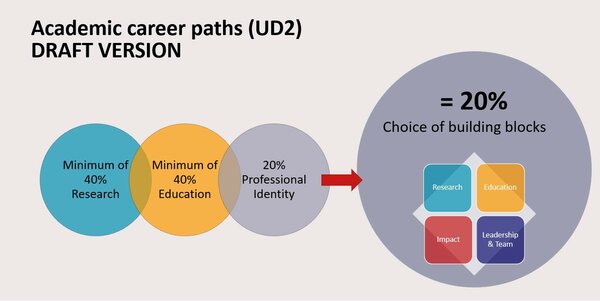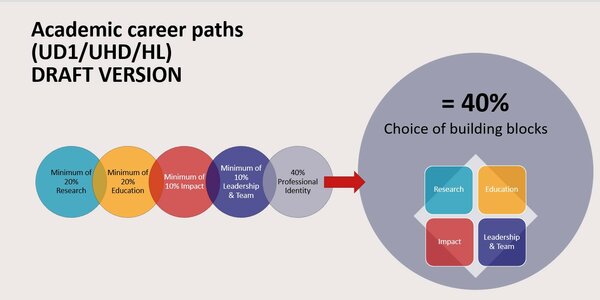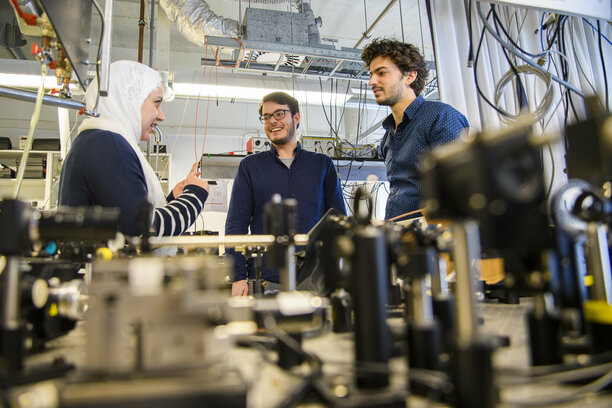‘Giving room to the individuality of our people’
Thanks to Recognition and Rewards, frameworks for various career paths are now being formed. Rector Silvia Lenaerts calls on everyone to generate input.

Rector Silvia Lenaerts cherishes the diversity of our scientists. In their background, vision and passion. “Not everyone has to do the same thing, there is room for different career paths.” If you want to focus on teaching, research, impact or leadership, you can, thanks to Recognition and Rewards. The frameworks for this are now being formed, together with the departments.
If there is one thing Rector Silvia Lenaerts does not want, it is to judge the careers of our scientists by strictly prescribed rules. She doesn’t want them to have to count research publications, check boxes and tick off key performance indicators any longer. “People should be given room to grow,” she argues.
The new Recognition and Rewards rating system for scientists allows for other career paths within the university world. There may be focus on research, teaching, impact and leadership, with the option to switch between those four.
Frameworks for young scientists
Above all, Lenaerts wants to give young scientists a clear framework. “What is expected of you when you start? For an assistant professor-2 (UD2), this means dividing their work with the following ratio: 40 percent of their time goes to research, 40 percent to teaching, and the remaining 20 percent is for professional and personal development. This is indicative,” Lenaerts stresses, “we’re not going to use a yardstick to measure that.”

We’re not going to count up points and hours; we're going to have a conversation about how you want to do your work.
Rector Silvia Lenaerts
She continues: “When you start as a UD2 you are mostly involved in teaching and research. In your early years as a scientist, you really need time to develop your own research and discover your own voice. You also often have a lot to learn in the field of education. How do you set up a course, how do you evaluate it? What forms of education fit and suit you? Using this broad base, you get the chance to discover that.”

Those frameworks may seem strict, but Lenaerts says they are mainly intended to protect young scientists. “This way they know what is expected of them. In addition, we also give them the autonomy and freedom for their personal development.”
Much attention to annual reviews
Good annual reviews are an important tool in fleshing out the framework. Julma Braat, policy advisor for Recognition and Rewards at Human Resources Management (HRM), clarifies. “With your supervisor or group leader, you discuss what development you want to undergo in the short and long term and how you will adjust your task package accordingly.” Adjustment is always possible, Braat emphasizes. “If an opportunity comes along that you hadn't foreseen, you want to keep the flexibility to seize it.”
Focus may shift
“How are you doing, what obstacles are you coming up against, what can you change? Are you getting stuck with research and want to shift your focus more toward education? That should be possible too.” Lenaerts adds. “There are phases in life when one thing fits you better and works better than another. We offer the mobility and flexibility to go along with that.”

We really take the time to develop this together.
HR policy advisor Julma Braat
Lenaerts says a different kind of annual review requires something from managers within the departments. “Human Resources Management provides support to departments for this. What does a dean or manager need to conduct these review interviews well? What tools can we give them?”
Learning organization
“I like the fact that we have such good conversations with the deans about this,” says Lenaerts. “I see that some departments are already working on it, and are already showing great results. I think that’s positive, because we are a learning organization.”
“We really take the time together to talk things out and develop this together,” Braat confirms. “That way we get a good idea of what the departments feel is important.”
The next step
Going back for a moment to the frameworks for young scientists. These change significantly in the flow toward UD1 and higher positions (see the figure below).

The proposed ratio - the frameworks are still being discussed within the university - offers more freedom to organize your work, Lenaerts says. “You spend one day on teaching, and one on research. In addition, we think it is important that our scientists are also involved with the impact of their research or teaching on society. And that they work on their personal development. How do you supervise yourself and within your team? How do you ensure that others can flourish?”
We don’t expect everyone to do everything. You may focus on what suits you best, within the framework of your team.
Rector Silvia Lenaerts
Plenty of food for thought - and to engage in the conversation together, says Lenaerts. “Not everyone has to do everything. We expect people to focus on what suits them best. Taking into account, of course, the team in which they work, and the academic values of the university. That means having an eye for each other, taking care of each other, working together and giving room to each other and to each other's ideas.”
Biographical sketch
Plenty of opportunities within Recognition and Rewards beckon for scientists. But there is also work to be done: creating a biographical sketch - bio sketch in short. “We want our people themselves to write what they find important and what they have achieved within education, research and valorization,” says Lenaerts.
"The bio sketch is our form of an evidence-based narrative resumé,” Braat adds. “in which they can show their ambition and talents and the direction they want to go. They can explain why they made certain choices in their career path. We ask scientists to share what they have achieved in all four areas of focus (teaching, research, impact, and leadership and team, ed.). And what their vision for the future is in those areas.”

We ask scientists to cite important accomplishments rather than a long list of publications.
Rector Silvia Lenaerts
Providing an exhaustive list of publications is no longer the required burden of proof, Lenaerts explains. “For example, we ask them to name five important achievements. That could be the first publication in a new field, a special collaboration, something they are very proud of, something they want to build on. But it can also be a patent for which they have applied. The personal explanation is important and makes it more fair than the hierarchy of where you stand in a publication’s list of authors.”
Input is most welcome
Lenaerts realizes that assessing scientists in this way also requires something of the assessment committees. “They need to be prepared for this so we must train them to take a broader and different perspective, something that is called for within Recognition and Rewards. Now is the time to think about it. The discussions are brewing in fine conversations with the deans of our departments. All input from our community is welcome in this regard,” she concludes.
More on our strategy



